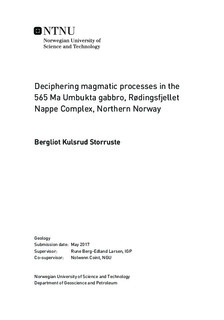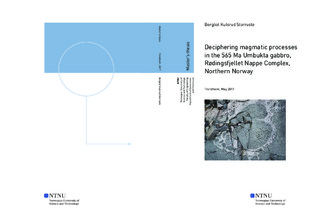| dc.description.abstract | The Umbukta gabbro, emplaced in Rødingsfjellet nappe complex in Nordland, have been investigated, with focus on the geochemistry, field observations and petrography. This tholeiitic gabbro has an intrusive age of 565 ± 20 Ma, uncommon for igneous rocks in the region. The primary objective of this master s thesis is to constrain the petrogenesis of the gabbro and to further investigate the relationship between the Umbukta gabbro and the synchronous Seiland igneous province, emplaced in the Kalak nappe complex, in Finnmark. Whole-rock major and trace elements compositions were obtained from XRF, ICP-AES and LA-ICP-MS analysis, and mineral chemistry was obtained from EPMA and LA-ICP-MS analysis. Fractional crystallization modelling of an evolving melt composition, was performed using whole-rock trace element concentrations and partition coefficients from literature. In addition, 10 samples were analysed for Sm-Nd isotope composition. Igneous rocks associated with the Umbukta gabbro include olivine gabbro, olivine-free gabbro, monzodiorites, monzonites, diorites, granodiorites and felsic granitoids. Olivine gabbro represent the most mafic rock group and show compositions up to An66 and Fo71, with MgO levels up to 21 wt%. All rocks except the felsic, show an enriched REE pattern, thought to stem from an enriched source, with a decreasing trend from La to Lu and no Eu-anomaly. Petrographic and geochemical studies, as well as field observations and trace element modelling, suggest that the range from ultramafic to intermediate compositions may be explained by fractional crystallization. A contact zone between the gabbro and the metasedimentary host rock in the north, is characterized by mingling between a peraluminous, muscovite-bearing granodioritic component and a mafic component. The granodiorite, which contains abundant metasedimentary xenoliths, is interpreted as the result of crustal anatexis in the aureole of the pluton. Mafic rocks display εNd values from -2,5 to +5,6, and show a strong correlation between εNd and trace
element signature. Evidence for contamination is generally constrained to the margins of the
pluton, which suggest that the pluton experienced crustal assimilation at the level of emplacement.
These findings, combined with an excellent rate of exposure, makes Umbukta a highly
appropriate locality for studying mixing and assimilation processes related to emplacement of
mantle-derived magma.
Similarities between tholeiitic rocks from Umbukta and the Seiland igneous province investii
gated in this thesis, include a wide range of εNd values, representing both mantle and crustal
isotopic signatures, and strongly enriched REE patterns relative to chondrite. These similarities
is taken to indicate that similar processes may have been responsible for the formation of the
tholeiitic rocks from the two regions; dominantly fractional crystallization with associated assimilation
of crustal rocks. In addition, similar εNd values (∼5,5) and trace element patterns for
the less contaminated samples, imply they could stem from a similar source, linking these two
igneous systems to a widespread magmatic event. | |

